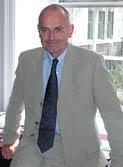Newsbites (Page 6)
New Dean for Arts Renaissance

BG Bibeault
He's taking over a faculty that's bigger than a number of Canadian universities, with nearly 7,000 undergraduate and graduate students. And he does so at an exciting time for the Faculty of Arts, as it enters what's been dubbed the "Arts Renaissance." John A. Hall is a world-renowned sociologist whose expertise is broad-ranging, from history to economics to political science and more - much like the faculty he now runs.
"He's a brilliant lecturer," McGill Provost and Vice-Principal (Academic) Luc Vinet told the McGill Reporter, "so we have a combination of research at the highest international standards and somebody who really cares about teaching. He'll be a great leader for a faculty that is very important to the University."
McGill's former chair of sociology has been in the dean's seat since June and is busy putting his priorities in line. "I'm concerned with assuring the intellectual quality and vitality of new faculty members," says Hall, who will see they are given appropriate time and space to do their research. "They are the future of the faculty." Arts is undergoing quite an infusion of new professors, with 50 additional positions currently being filled, and aggressive hiring is to continue over the coming years. To help both the recent arrivals and current academics, the faculty has put a new research officer in place.
Hall is also making the quality of arts education a top concern, working on a pilot project of core curriculum for first-year students that will introduce them to "a non-Eurocentric, up-to-date program of study that examines great books and great institutions." As for who is shaping those students' minds, says Hall, "I want to get more of the best and senior faculty teaching undergraduate courses."
The intellectual vitality Hall speaks of is a key component of the faculty's Arts Renaissance. The campaign of renewal on the academic side involves "building and developing the existing strengths of the faculty," says the dean, "for example, in Shakespeare Studies, in Political Science, or Anthropology. I'm impressed with the sheer output of research across the faculty with what have been limited resources." At the same time, he wants to "make sure we capture emerging areas of research and development, for instance in ethnic conflict, nationalism or globalization."
The Arts Renaissance will include physical development as well, and one of the Dean's priorities is to find funding for the construction of a much needed new Arts Building, to be located across from the Faculty of Law at the northeast corner of Dr. Penfield Avenue and Peel Street and budgeted at approximately $40 million.
"The faculty is spread out over 18 different buildings," Hall points out. "The issue of space is very difficult. There's no electricity between key people because they're at such a distance. I'll be putting in a great deal of effort to find money for this new building."
Redpath Revived

Owen Egan
One of Canada's most venerable museums is looking brighter in the wake of a recent makeover. While the renovations to McGill's Redpath Museum, first opened in 1882, were principally aimed at bolstering its research and teaching efforts, there is no arguing that the museum is also now a much more pleasant place to while away an afternoon.
The floors have been stripped and refinished, attractive new display cases have been added, and more window space was opened up. "It has a lighter feel to it now," says biology professor Graham Bell, the museum's director. "The main purpose behind the renovations was to create a thematic core for the museum's collections," explains Bell. The centrepiece for the changes is a new permanent exhibition highlighting the biological diversity of Quebec and how the province has played host to a number of remarkable historical occurrences - the emergence of the first land plants and amphibians, for instance. One exhibit features a diorama depicting the sea floor in the region of Montreal during the Ordovician period, 450 million years ago.
This month, an ethnological exhibit will open on the third floor, focusing on the museum's Egyptian holdings - including the Redpath's trade-mark mummies. Other exhibits dealing with ancient artifacts from other parts of the world will be unveiled in stages - some next year, some in 2005.
A few former Redpath residents have returned to their old digs. A number of stuffed animal exhibits, long consigned to storage space rented by McGill at the Masonic Temple, have been spruced up and reclaimed, including a whooping crane, the tallest and one of the rarest birds in North America, and an Eastern cougar, once plentiful in these parts but now thought to exist only in Western Canada.
Bell recalls a memorable trip to the temple with Ingrid Birker, the Redpath's Curator of Invertebrate Paleontology, to repatriate a muskox. "Ingrid was wrestling with the [muskox] in the back of a truck as we drove back. Heads were turning - it's not the sort of thing you usually see on Sherbrooke Street."


